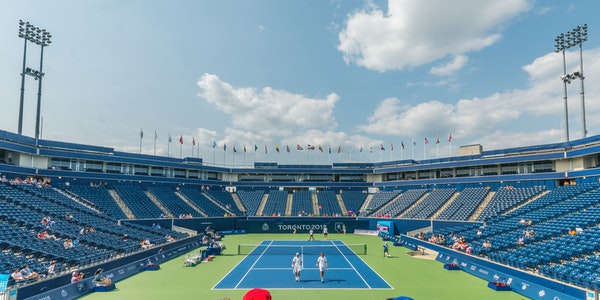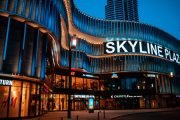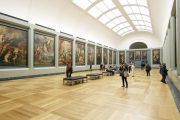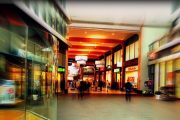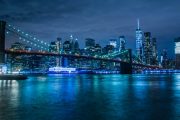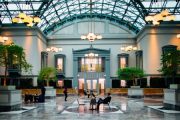1. Introduction
Due to its wide area, large volume and special architectural form, stadiums often become local landmark buildings and cultural and entertainment centers once they are built. Therefore, the facade lighting of such buildings should be paid special attention. The facade lighting design of such buildings should be based on the grand architectural form, combined with the surrounding environmental art, and can fully reflect the local human history, political economy and cultural background.
2. Definition of Facade Lighting
The so-called facade lighting, also known as building lighting, is the lighting that reshapes the nighttime landscape of buildings with lights, which is a part of nighttime lighting. The purpose is to use the lighting to highlight the characteristics of the building, and organically combine it with the surrounding environment to create a harmonious, beautiful and distinctive night scene picture, so as to express the night image of the building.
3. General Design Principles for Facade Lighting
Facade lighting design should follow the following general principles:
(1) The lighting design of buildings should meet the requirements of the special planning for urban night scene lighting, and should be carried out simultaneously with the engineering design.
(2) The values of illuminance, brightness and lighting power density shall comply with the corresponding national regulations. Choose energy-saving light sources and high-efficiency lights, and avoid blindly pursuing effects and use light sources and lights without restrictions, resulting in energy waste.
(3) Reasonable selection of lighting sources, lights and lighting methods. Effectively utilize the color rendering index of different light sources, the light distribution curve of lights and the changeable lighting control methods to achieve the best artistic and visual effects.
(4) Reasonably determine the installation position, illumination angle and shading measures of lights to avoid light pollution and glare.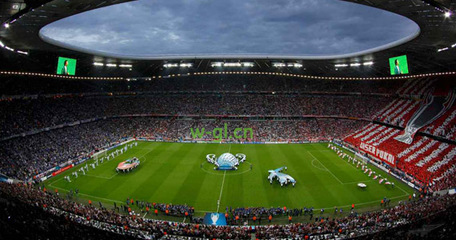
(5) Choose color light carefully. When large-scale open-air stadiums host some important competitions and performances, a large number of spectators will gather and disperse in a short period of time. Therefore, evacuation instructions and the prominence of traffic signals are particularly important. In addition, in the process of holding events, in order to truly reflect the effect of the scene, sometimes aerial photography technology is used. Therefore, in the design of night scene lighting, the light color selected for night scene lighting should not cause visual confusion with traffic, shipping and other signs while ensuring that it is in harmony with the characteristics of the illuminated object and the area where it is located.
(6) Lighting facilities should take corresponding safety precautions according to environmental conditions and installation methods to avoid casualties.
4. Sports Building Facade Lighting Design
The design principles of sports building facade lighting should highlight the functional characteristics of sports buildings. Considering the characteristics of the main body of the building, such as the large area and the huge size, combined with the surface color of the building, the different colors of light are used to reasonably select the appropriate viewpoint, so as to coordinate with the building and the surrounding squares, commercial and other cultural environments. The facade lighting fixtures should be combined with the building components of the walls, columns, eaves, windows, corners or roofs of the building facade, and the influence of the projection direction of light and the installation position of the fixtures on the building and the overall artistic effect should be fully considered.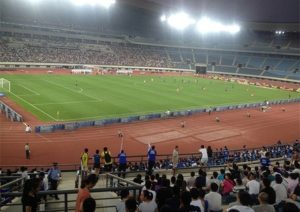
4.1 Flood lighting
Flood lighting is the use of light projection devices to illuminate the facade of a building to express the appearance of the building. Typically used for main facade, side and contour lighting of buildings.
For main façade lighting, especially when the façade is mostly flat, the spotlights mostly use medium beam (irradiation angle between 30° and 70°) or wide beam (irradiation angle > 70°) lighting fixtures. When used for side or contour lighting, medium beam or narrow beam (illumination angle between 10° and 30°) lighting fixtures are mostly used for spotlights. When it is necessary to highlight a certain feature of the building facade, narrow beam or ultra-narrow beam (illumination angle 5°) lighting fixtures can be selected.
According to the different shapes of lights, floodlights can also be divided into two types: circular floodlights and square floodlights.
Circular floodlights generally have a small beam angle, have strong directivity, and are symmetrical floodlights.
The square floodlight generally has a large beam angle and a wide irradiation area, which is an asymmetric floodlight.
Which kind of floodlight should be selected should be determined according to different spaces and different expression effects.
Metal halide lights, high-pressure sodium lights, and LED lights are commonly used as flood light sources. Incandescent lights and high-pressure mercury lights are rarely used because of their low luminous efficiency and high energy consumption.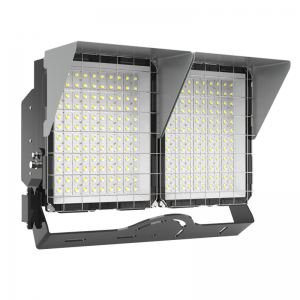
Metal halide lights:
That is, a discharge light that generates arc discharge light in a mixed vapor of mercury and a halide of a rare metal. It is a high-efficiency light source made by adding various metal halides on the basis of high-pressure mercury lights. The low-pressure metal halide charged into the light tube determines the luminous performance of the light, and different metal halide lights can be made into light sources with different characteristics. Metal halide lights are the most widely used in outdoor lighting due to their high luminous efficiency, long life, good color rendering, and relatively cheap price.
HPS:
It is a high pressure sodium vapor discharge bulb, which emits golden white light when working. High-pressure sodium lights must be connected in series with ballasts corresponding to the bulb specifications before they can be used. It has the advantages of high luminous efficiency, low power consumption, long life, strong fog-penetrating ability and no insect trapping.
LED flood light:
LED is a solid semiconductor chip as a light-emitting material, and a forward voltage is applied to both ends to cause photon emission to produce visible light. LED floodlights are mostly composed of several 1W LED light sources. As a new type of light source, it has been widely used in outdoor lighting due to its high efficiency, energy saving, low energy consumption, good controllability and rich colors. But because it needs a matching control chip, the price is relatively expensive.
Xenon light:
It is a headlight containing xenon gas, also known as high-intensity discharge gas light. Its working principle is to fill the high-pressure inert gas – xenon gas in the quartz light tube, replacing the traditional filament. There are mercury and carbon compounds on the electrodes at both ends, and the xenon gas is stimulated to emit light through a high-voltage current of 23,000 V, forming a perfect white arc between the two poles, and the emitted light is close to sunlight.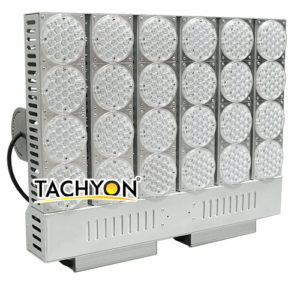
Xenon lights are mostly used for high-power searchlights because of their high brightness, long irradiation range, good color rendering performance, close to sunlight, fast startup, and long life. It is this feature that is used in the lighting design of the stadium facade. Several sets of xenon lights are erected at the outer edge of the stadium roof, and the white beams emitted by them are used to create a festive atmosphere, which should be regarded as a special form of floodlighting.
In the flood lighting design, different lights and light sources should be selected reasonably. Using the color temperature of the light source and the different projection angles of the lights, the changes in light color are cleverly used to reflect the unique style and characteristics of the building. Metal halide floodlights are installed on the roof and the bottom around the stadium, focusing on highlighting the grand effect of the sports building, and making the outline and corners clear to ensure the integrity of the stadium building. In addition, the illumination of the floodlight makes the brightness of the building significantly different from the surrounding environment. In the choice of light color, the color contrast with the surrounding environment is formed, and at the same time, the coordination with the surrounding overall environment is ensured.
4.2 Internal light transmission
A lighting method that transmits the light inside the building to the outside of the building by using the holes, holes and windows of the building. This is also a common expression method in the facade landscape lighting design of sports buildings. It is especially suitable for building exterior walls with glass curtain walls and exterior facades with large light-transmitting areas or when using surface materials with a reflection ratio of the illuminated surface lower than 0.2.
The commonly used light sources for internal lighting are fluorescent lights and LED lights.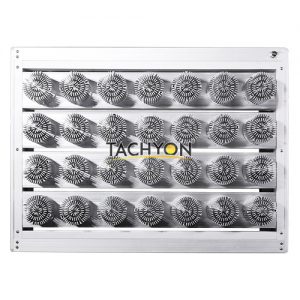
LED lights can emit different colors of light through different colors of transmission sheets, and the colors are rich and changeable.
The stadium cleverly uses the irregular holes on the outer wall of the building, uses the change of LED light source, and makes the whole building full of agile and lively atmosphere through the design method of internal light transmission. Avoid visual oppression due to the excessively large volume of sports buildings.
In addition, because the stadium is equipped with a large cable-stayed arch, the surface of the arch is selected from a building material with better light transmission performance. In order to fully express her integrity and grand characteristics, the method of internal light transmission is also adopted in the arch, and several sets of 150W REB LED floodlights are installed to make the arch become a semi-circular self-contained light at night. illuminator. The selection of LED lights here means making full use of the fact that LED lights can change colors through the internal control chip, and change colors according to different time and scene settings, so that the arches and the holes on the curtain wall below echo through the changes of different lighting colors. , making the whole building lively and vivid.
(To Be Continued)

